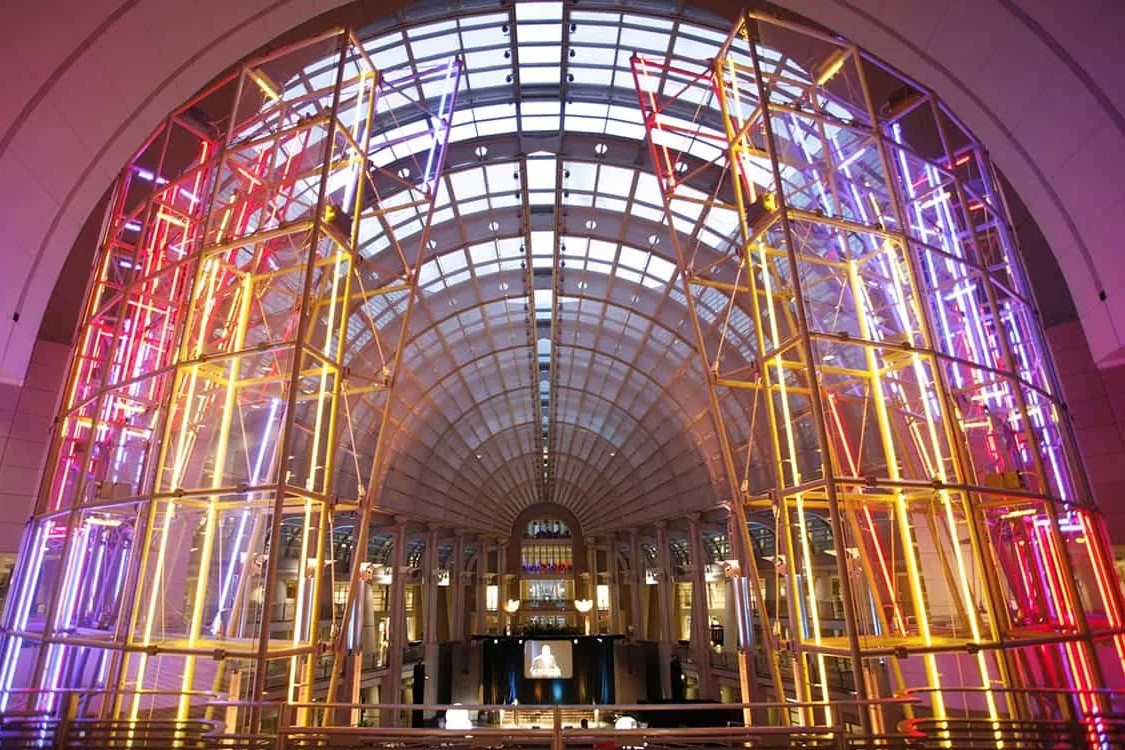
Pushing forward with green initiatives
Post filed in: Buildings | Climate | Energy | Fleet | GSA Fleet | Green Proving Ground | Innovation | Sustainability
Reducing waste – whether it be spatial, financial or environmental – across the federal government was a top priority for the agency in 2023 and will continue to be so in the new year.
In Massachusetts, GSA finalized a deal with the Department of Transportation and Massachusetts Institute of Technology (MIT) when it opened the Volpe Center in the tech-forward neighborhood of Kendall Square.
The Volpe Center boasts sustainability features both inside and out. The building’s exterior includes solar panels, storm water capture systems – providing 100% of what’s required for irrigation, eliminating the need to use drinking water to water the plants – and two occupiable green roofs, just to name a few.
Inside, lighting will run on sensors, turning off and on depending on occupancy. Automatic shades will assist the already efficient cooling and heating systems. Floor layouts and furniture placement were designed to maximize views and daylight.
Many GSA properties are actively reducing their carbon footprint by going 100% electric and buying carbon-free electricity.
Historical investments in sustainability underway
The Inflation Reduction Act — which celebrated its first birthday in August — and 2021’s Bipartisan Infrastructure Law, are funding major sustainability efforts in GSA’s portfolio, including those listed here:
GSA announced last month that it awarded a nearly $23 million contract to electrify the 3.1 million square foot Ronald Reagan and International Trade Center, the headquarters for the U.S. Agency for International Development. The building also houses offices for many other federal agencies and a foodcourt popular with tourists.
Electrifying the building is expected to save over $6.3 million in energy costs annually and reduce emissions by 16,000 tons–or the equivalent of 511,820 gas-powered vehicles taken off the road each year.
The agency also announced in November it will invest $2 billion toward low-embodied carbon (LEC) construction materials at 150 projects nationwide. Embodied carbon refers to the greenhouse gas (GHG) emissions associated with the manufacturing, transportation, installation, maintenance, and disposal of construction materials. Buildings and construction materials are responsible for 40% of carbon emissions, making them the fourth largest global contributor, GSA’s Chief Architect said in 2021.
Before November’s announcement, GSA had been working to pilot LEC steel, asphalt, concrete and glass at several land ports of entries (LPOE) projects and other locations. Lessons learned from the pilot program will be applied to the new round of LEC construction projects, spurring the market for clean construction materials.
From green tech to green roofs
The agency’s Green Proving Ground, a partnership with the Department of Energy, received $30 million in IRA funds. GPG uses GSA’s substantial real estate portfolio to test innovative building technologies that cut back on wasteful air leakage or water use in federal buildings.

Some buildings in GSA’s real estate portfolio weren’t just a hive of activity of people and sustainability efforts, they were literal hives. Hives as in bees, butterflies and other pollinators. The Pollinator Protection Initiative pilot program came to an end in early 2023 and proved what models can be used to host hives at GSA-owned or -leased facilities in both urban areas and at large, sprawling federal campuses. Pollinators will continue to work at selected buildings across the nation.
Federal green roofs — also known as vegetated roofs and living roofs — have dated back to the 1930s. Now, GSA owns one of the largest planted roofs in the world, specifically the U.S. Coast Guard Headquarters in Washington — proving the return on this sustainability investment was more than just a pretty view.
Sustainability in procurement and acquisition
The procurement and acquisition side of GSA also continued its sustainability efforts in 2023.
GSA launched its Acquisition Policy Federal Advisory Committee focusing on emerging acquisition issues, challenges, and opportunities to support GSA’s role as America’s buyer in 2022. The committee remained focused on sustainability this year as it discussed topics such as standardizing ecolabeling, how products are marked so consumers know they’re “environmentally preferable.”
GSA’s sustainability efforts don’t go unnoticed. For the seventh year in a row, the Office of GSA IT won a national award recognizing organizations that buy and sell sustainable and environmentally friendly electronic products.
GSA provides more than 230,000 vehicles to agencies across the federal government, one of the largest fleets in the world. GSA’s Fleet management program continues to drive toward President Biden’s call to electrify the fleet by 2035. In the past two years, zero-emission vehicles orders at GSA Fleet are up sixfold as the agency supports customers with charging infrastructure.
Perhaps the greenest effort was GSA’s role in the FDA acquiring goats, replacing power tools and herbicides to remove, er… eat … an invasive plant at FDA’s headquarters in Silver Spring, Maryland.
This is the second of the two-part series. In case you missed it, check out part one of GSA’s wins in 2023.
Happy New Year!

 U.S. General Services Administration
U.S. General Services Administration
